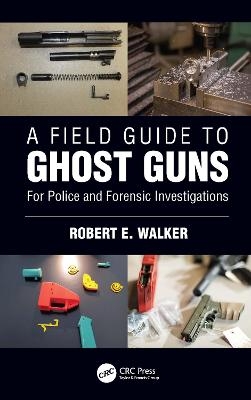
A Field Guide to Ghost Guns
CRC Press (Verlag)
978-0-367-49095-9 (ISBN)
While it has always been legal for a citizen in the United States to manufacture their own firearm, the sale and distribution of such items is illegal under current U.S. law. The primary impediment to individuals making their own weapons has been access to the tooling and machinery required to convert raw materials into finished parts for assembly. However, in the last fifteen years this paradigm has changed drastically. Home builders and companies have emerged to support individuals who choose to produce their own firearm. Kits with receivers and gun components are available for hobbyists, as are 3-D printable gun designs, downloadable from the Internet in some cases. This phenomenon has led to the term ghost guns: firearms whose existence is not reported to any third party and therefore whose existence is unknown and, largely, untraceable.
A Field Guide to Ghost Guns: For Police and Forensic Investigators provides a useful brief for field investigators on the technical aspects of the self-made firearm, so-called "ghost guns. The first book to focus on the emergent issue of ghost guns, coverage addresses the history of firearms making and manufacture in the U.S.—including regulated and nonregulated manufacturing, details firearm components and accessories, how to assemble a Firearm, an overview of common Types of ghost guns, and investigative considerations.
Though there have been increased calls to regulate guns in the wake of numerous mass shootings, the proliferation of ghost guns—and their increasing use in crimes—would likely require additional laws and regulatory measures. Since there are few knowledgeable firearm practitioners in the field, who can render qualified opinions on the subject, author Robb Walker has taken a practical, pragmatic approach to the topic. The book defines terminology, provides photographs, and explains the concepts surrounding homemade firearm in clear, easy to understand terms.
Key Features:
Addresses the technology and technical aspects in creating, assembling, and/or modifying homemade firearms—both printable and assembled from pre-fabricated components
Discusses the rationale and motivations behind making one’s own firearm
Outlines what is currently legal and illegal under U.S. law, providing indicators for investigators for illegally configured firearms
A Field Guide to Ghost Guns addresses the pressing need for a practical reference on the topic. The book provides police investigators and forensic ballistics experts a useful aid to understand legal aspects and to identify ghost guns, and the paraphernalia—tooling and machinery, and otherwise—indicative of gun making in a non-formal, factory setting.
Robert Walker began working in the field of crime scene investigation in 1995. In 1996 he entered into an apprenticeship under the tutelage of a noted firearm expert and first qualified to render expert testimony in a court of law on a firearm case in 1999. In 2010, Robert earned his Certified Crime Scene Investigator rating through the International Association for Identification. He qualified as an expert under both Frye and Daubert standards in firearms, among other subjects, in the state of Florida’s Twentieth Judicial Circuit, The Federal Middle District of Florida, and the Federal Western District of Texas. Robert was an active teacher—serving as an adjunct faculty member at several colleges and a police academy instructor. Robert remains active as a firearms instructor and lecturer on topics related to crime scene investigation and firearms. Robert is a graduate of Barry University in Miami Shores, Florida. During his career, he had the opportunity to attend training at the FBI Academy in Quantico, Virginia and at the Office of the Chief Medical Examiner in New York City. He is the author of Cartridges and Firearm Identification (CRC Press, 2013) and Crime Scene Basics and Beyond (Cognella Academic Publishing, 2019).
1. A Brief History of Gun Making 2. Regulated and Nonregulated Manufacturing 3: The Frame, Firearm Components, and Firearm Accessories 4. Fabricating a Receiver and Assembling a Firearm 5. Common Types of Ghost Guns 6. Investigative Considerations
| Erscheinungsdatum | 20.12.2021 |
|---|---|
| Zusatzinfo | 7 Line drawings, color; 50 Halftones, color; 57 Illustrations, color |
| Verlagsort | London |
| Sprache | englisch |
| Maße | 156 x 234 mm |
| Gewicht | 371 g |
| Themenwelt | Naturwissenschaften ► Biologie |
| Recht / Steuern ► Allgemeines / Lexika | |
| Recht / Steuern ► EU / Internationales Recht | |
| Recht / Steuern ► Strafrecht ► Kriminologie | |
| Recht / Steuern ► Strafrecht ► Strafverfahrensrecht | |
| ISBN-10 | 0-367-49095-1 / 0367490951 |
| ISBN-13 | 978-0-367-49095-9 / 9780367490959 |
| Zustand | Neuware |
| Haben Sie eine Frage zum Produkt? |
aus dem Bereich


